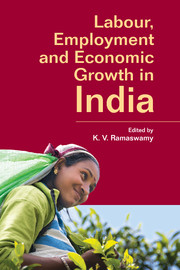Book contents
- Frontmatter
- Dedication
- Contents
- List of Tables and Figures
- Preface
- Part 1 Economic Growth and Employment
- Part 2 Employment and Labour Law
- 8 From Rigidity to Flexibility
- 9 Employment Protection Legislation and Threshold Effects
- 10 Who is a Worker?
- 11 Labour Jurisprudence of the Supreme Court
- Contributors
- Index
11 - Labour Jurisprudence of the Supreme Court
from Part 2 - Employment and Labour Law
Published online by Cambridge University Press: 05 June 2015
- Frontmatter
- Dedication
- Contents
- List of Tables and Figures
- Preface
- Part 1 Economic Growth and Employment
- Part 2 Employment and Labour Law
- 8 From Rigidity to Flexibility
- 9 Employment Protection Legislation and Threshold Effects
- 10 Who is a Worker?
- 11 Labour Jurisprudence of the Supreme Court
- Contributors
- Index
Summary
Introduction
Following the adoption of the new economic policy by the Government of India in 1991, there have been significant changes in the employment pattern in industrial establishments in the country on account of the array of low cost flexible labour practices adopted by employers. There has been a steep increase in the employment of precarious workers while the share of the permanent workforce has considerably declined. Contract workers and other kinds of non-regular workers are engaged in large numbers to perform work of a regular or permanent nature. They are however paid substantially lower wages than permanent workers doing work of the same or similar kind. Disguised employment is rampant and workers are often engaged under sham contracting arrangements and in the guise of trainees and probationers to keep labour costs low and also to circumvent the law. Other practices adopted by employers to cut labour costs and circumvent the law include sub-contracting, outsourcing jobs and keeping the number of workers below the threshold level prescribed under the law. The designation of workers as managers, supervisors, engineers etc. is yet another strategy adopted by employers to circumvent the law. The weak enforcement of labour laws by the state machinery has facilitated the adoption of such practices.
Alongside the adoption of such practices, employers have been pressing for labour law reforms in order to give them greater flexibility in hiring and firing workers. Two of their main demands are the removal of provisions in the Industrial Disputes Act, 1947 relating to prior governmental provisions for effecting closures, and the lay-off and retrenchment of workers in industries employing a 100 or more workers and the removal of the restrictions on the use of contract labour under the Contract Labour (Regulation and Abolition) Act, 1970.
The increasing informalization of labour in the formal sector has disadvantaged workers in the sector in more ways than one.
- Type
- Chapter
- Information
- Labour, Employment and Economic Growth in India , pp. 292 - 318Publisher: Cambridge University PressPrint publication year: 2015
- 3
- Cited by



